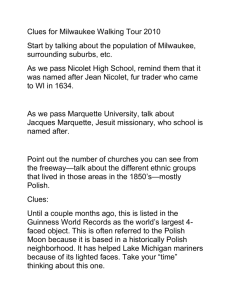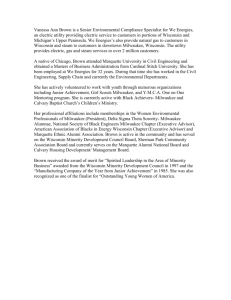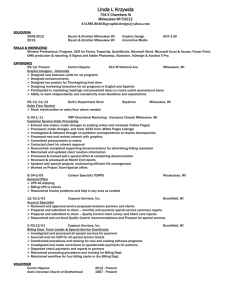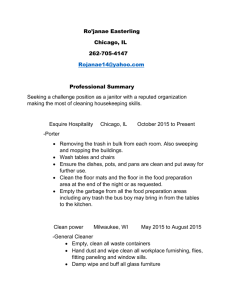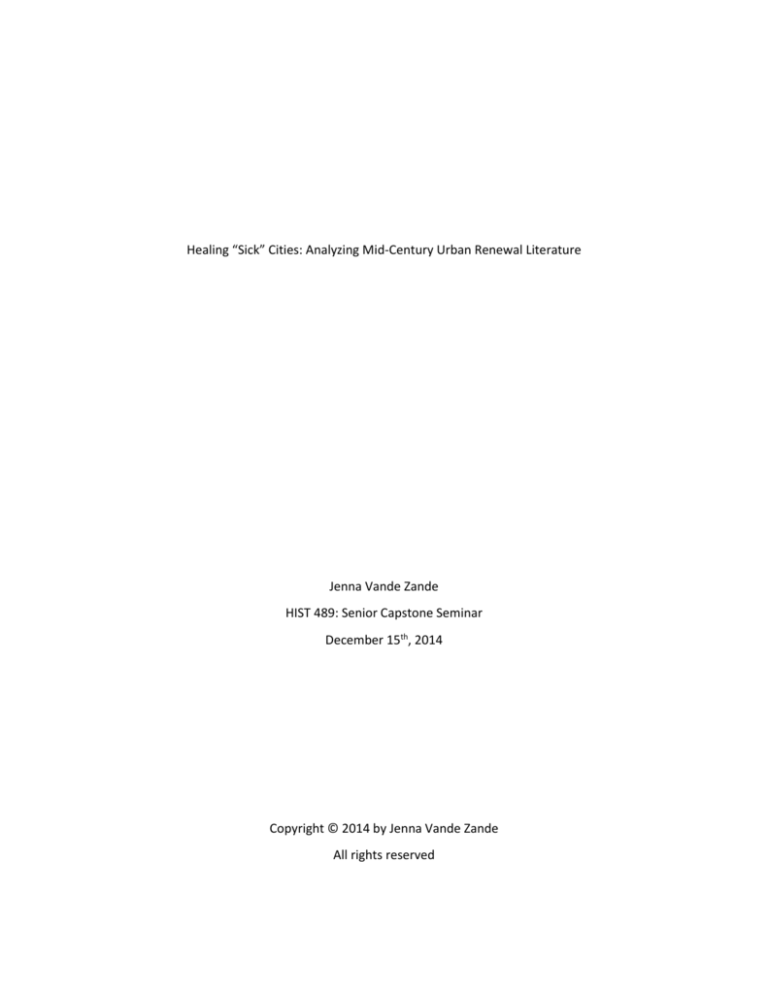
Healing “Sick” Cities: Analyzing Mid-Century Urban Renewal Literature
Jenna Vande Zande
HIST 489: Senior Capstone Seminar
December 15th, 2014
Copyright © 2014 by Jenna Vande Zande
All rights reserved
Contents
Introduction
1
Decentralization
4
Discrimination in Financing
5
City of Milwaukee – East Side Plan
13
Activism in Response to Urban Renewal
22
Backlash to the Suburbs
24
Conclusion
26
Abstract
Mid-century city planners often made the ultimate decision to determine which areas
were too “sick” to save, who was allowed access to the new spaces, and who was not.
The bias against minorities and anyone who was not considered the perfect tenant is
evident in the three types of documents analyzed in this paper: books on urban
planning, city plans and reports, and federal government housing policies. Planners
would often use the metaphor of the human body and disease when discussing the
“cancerous” slum areas in the city whose only treatment was swift extraction. This very
narrow focus of mid-century city planners made them unwilling to see the city as many
connecting parts that relied on each other for success. This was especially true in the
city of Milwaukee, Wisconsin as developers quickly removed families out of the East
Side neighborhood between Lake Michigan and the downtown area in order to build
new, modern office space and residential buildings. However, the East Side plan was
only part of the problem concerning discrimination against minorities. Civil rights
protests regarding issues like opening housing, fair employment, and neighborhood
support played a large role in Milwaukee politics during the 1950s and 1960s but many
demonstrations were met with violence from opposing white homeowners. When city
planners established which neighborhoods were worth treating for urban decay and
which would be ignored or removed, they did not consider the ramifications of their
actions.
1
Introduction
The broader urban vision for the American city went through a period of great change
after World War II through the 1960s. After the Great Depression, part of the massive shift in
thinking that occurred in America included a bias to ‘new’ and dismissal of the old. All over the
country, people wanted a fresh start. Living in old, cramped cities was no longer the desirable
mode of living and people moved in droves to new housing developments in the suburbs. Then
the residents needed to buy new furniture and new cars to fill all the new houses and garages.
This is a considerable shift from the Great Depression idea of frugality and the old adage: “use it
up, wear it out; make it do, or do without” that graced propaganda posters as the country tried
to have enough for its citizens at home and abroad. Reuse of material goods was an integral
part of American daily lives through the Great Depression. The modern consumer culture had
started to take control during the 1920s as Americans were buying into new products intended
to make daily tasks easier like the vacuum cleaner or processed foods. However, the start of the
Great Depression required many Americans to return to thrifty reuse practices.1 As the country
pulled itself out of the Great Depression, the combination of sheer quantity of items that
became available for sale and an expanding middle class allowed for greater consumption of
these goods. However, in the early part of the century before the first consumer boom, the
focus was still on quality goods that could be reused. In a Ladies Home Journal article from
1911, a son explains the relatively new government concept of environmental Conservation his
mother. The examples he uses to explain how the government wishes to reorganize their
1
Susan Strasser, Waste and Want: A Social History of Trash, (New York: Metropolitan Books, 1999): 161-202.
2
environmental efforts offers a pointed insight into the American ideology behind the worth of
goods:
“when you open a parcel from the store do you throw away the paper and string? Not a bit of it.
You smooth out the paper and roll up the strong, and lay both aside till you wish to wrap a
package yourself… The bones the butcher sends home with the meat you drop into the soupkettle, and the surplus fat into the soap can…So you have been practicing conservation all your
life…If the Government had begun as long ago as you did the people of the country would have
been educated to the idea by degrees, just as you educated us boys not to be stingy, but to
despise waste.”2
It would never have occurred to the author that in a few short decades, things like package
wrapping or useable parts of a hunk of meat would be tossed away. This new idea of a “throw away” society focused only on new things and buildings applied directly to mid-century city
planning. Urban designers faced decaying cities all over the country and many wanted to cut
out the bad portions, build new structures, and add support only to areas that they determined
to be valuable space. Many planners explained their views of the city using the metaphor of
the human body, describing the urban environment as a complicated organism that needed
“treatment” for its “ill” sections or suggesting swift removal of its “cancerous” areas like slums .
However, buildings cannot be tossed aside as easily as a scrap of wrapping paper. As much as
urban planners lamented the slums and blighted neighborhoods, limited funds and grassroots
neighborhood campaigns forced city planners to re-figure their designs to include more of the
established environment. Communities already living in areas targeted for demolition
demanded that they should be allowed a voice and began grassroots efforts in cities all over the
United States. Neighborhood groups, especially in minority communities, began to organize in
response to overreaching city planners and forced them to consider the individuals in the
2
Ladies’ Home Journal 28 (November 1911), pp. 23, 95.
3
neighborhoods they were attempting to throw away. In Milwaukee, Wisconsin, a number of
African American led community groups like the renowned Milwaukee Urban League were
established to save and stimulate investment into their neighborhoods.
After the flight to the suburbs, mid-century urban renewal attempted to bring people
back to the city through the massive urban renewal construction projects offering residential
and commercial space, as well as amenity space like shopping complexes. Land developers
always look for the optimum locations to maximize their investment so not so coincidentally,
renewal efforts frequently occurred on the best land the city had to offer. One such urban
renewal project published in 1959 focused on the East Side area of the city of Milwaukee,
Wisconsin along Lake Michigan. City planners wished to build new, modern lakefront residential
and commercial properties to replace the older housing, businesses, and manufacturing
properties on the land. A great divide in the field of urban planning developed during this time
as most experts argued about investing in areas like slum neighborhoods they deemed severely
blighted and too “ill” to save. Others like revolutionary Jane Jacobs insisted that to save
American cities, planners needed to keep and enhance the established urban fabric to save
intimate neighborhoods.3 This bias against “sick” sections of the city is identifiable in the
language of the city plans and reports, as well as the books written by experts in the field of city
planning. This is especially true of the proposed redevelopment for the East Side of Milwaukee.
While at first glance, the Plan may appear to “treat” the city’s problems and promote
investment in the downtown, further inquiry allows the reader to see what has been glossed
3
Jane Jacobs, The Death and Life of Great American Cities, (New York, NY: Random House Inc., 1961): 178-221.
4
over to sell the development. The Plan was a textbook example of planners relocating people
out of a desired construction location with less thought about the needs and circumstances of
the people currently living in the area and facing removal.
The organization of city planning should be twofold: the expertise of the architect
aligning with the wants and needs of the inhabitants. However, it was evident in mid-century
city planning that the supposed wants and needs of the inhabitants could be adjusted,
reframed, or ignored to meet the desires and biases of the expert . This was especially true in
the city of Milwaukee as city planners made the ultimate decision to determine which areas
were too “sick” to save, who was allowed access to the new spaces, and who was not.
Decentralization
Decentralization is the redistribution of a population and industry from urban centers to
outlying areas.4 City planning expert Eliel Saarinen was a major supporter of decentralization as
a partial solution to “free the city from the contagious danger of slums” which he described as
“cancer in the urban body.”5 Saarinen was already well known for his architectural design in his
home country of Finland when he moved to the United States in 1923, where he influenced
skyscraper and church design. Saarinen is most well-known for his presidency of Cranbrook
Academy of Art near Detroit where he headed the graduate department of architecture and
city planning.6 He published one of his recognized books The City, Its Growth, Its Decay, Its
4
Merriam-Webster’s Collegiate® Dictionary, s.v. “Decentralization,” accessed November 12, 2014,
https://login.proxy.uwec.edu/login?qurl=http%3A%2F%2Fsearch.credoreference.com%2Fcontent%2Fentry%2Fmw
collegiate%2Fdecentralization%2F0.
5
Eliel Saarinen, The City, Its Growth, Its Decay, Its Future, (New York: Reinhold Publishing Corporation, 1943): 147.
6
Encyclopedia Britannica Online, s. v. "Eliel Saarinen,” accessed November 11, 2014,
http://www.britannica.com/EBchecked/topic/514860/Eliel-Saarinen.
5
Future in 1943 and his commentary on decentralization offers an insight into the urban
planning literature that was taught during the upheaval of mid-century urban renewal projects.
Saarinen attributed the “general need of urban liberation from the existing deteriorating
compactness” as one of the main causes for decentralization along with the desire for “freer
and airier living conditions.” 7 He credited the advancements in understanding human health to
a more health conscious population that “now prefers to be surrounded by gardens and the
freshness of nature.”8 Saarinen used the human body as a metaphor for the urban environment
throughout The City and through this metaphor, his distaste for slums and the people who live
there is very clear. He describes the slums as a cancer or dead organ that the city planner must
“amputate by a decisive surgery. And he must transfuse vitality only into those areas that are
protected against contagion.”9 With this bold statement, Saarinen attempted to use his
expertise and influence as a planner to establish a bias against slums by marking them as
impossible to save.
Discrimination in Financing
While scientific discovery may have been contributing to a growing health
consciousness, there were more significant factors that contributed to the mad dash to the
suburbs. Cramped spaces and traffic congestion, as well as social problems like class and racial
tensions, altered the concept of the city as a desirable place to live, which caused city dwellers
to move to the more open and natural spaces outside the city limits. Developers observed and
7
Saarinen, 147.
Saarinen, 148.
9
Saarinen, 144.
8
6
responded to these problems and designed campaigns tailored to market to a public that was
ready to move. As presented below, popular media depictions of the city often utilized fear
tactics or generalizations about city life that greatly contrasted to the safe suburbs that the
young, white couples in the cartoon are fleeing to.
Cartoon accompanying article titled “What Young People Think: Teens Want “Out” of Big City” Janesville Daily Gazette July 31, 1958.
Now all that was needed was a financial push to help people discover the white picket
fence and green grass of the American dream. Federally backed mortgages and loans from the
Federal Housing Administration and benefits for veterans like the GI Bill “put home ownership
within the grasp of thousands of middle-class and working-class Americans, often for the first
time.”10 Huge numbers of people were able to afford more than just the necessities of life and
could leave the city to pursue homeownership. The great shift in people also changed the
traditional designs of the neighborhood and public space. The “newly defined aesthetic of
prefabrication” inspired by mass-produced suburbs like Levittown, New York combined with
10
Patrick D Jones, The Selma of the North: Civil Rights Insurgency in Milwaukee, (Cambridge, MA: Harvard
University Press, 2009): 171.
7
the innovations in manufacturing and assembly lines that occurred during World War II led to
cookie cutter neighborhoods.11 Entire homes could be ordered out of catalogs and then the
pieces shipped to the suburbs and constructed next to dozens of nearly identical houses. From
1908 to 1940, Sears sold about 100,000 mail-order houses ordered straight from the Sears
Big Book; for “a few thousand dollars, buyers got floor plans, precut lumber, nails, paint,
doors, light fixtures, everything they needed, all delivered to the nearest railroad station.”12
According to a California newspaper article republished from the United Press in the San Mateo
Times in October of 1954, over a million new family homes (had) been added each year to the
number of homes in the United States since 1949.13 The article then continued by addressing
the positive impacts of the massive growth with the claim that “the housing surge was the
biggest single factor in fending off the depression since the war.” 14
After World War II, the expansive, mass-produced suburbs outside of the city “rekindled
a long-term American romance with the detached family home.”15 However, only certain
people were able to get financing options that would enable them to move out of the city, and
therefore the urban fabric of the city was forever changed. The middle class at this time was
primarily composed of white Americans who were able to apply for and obtain the financial
assistance offered by the government. Often African Americans could apply for the same
mortgage as whites and were denied based on a discriminatory practice known as redlining .
The construction and housing standards set by the Federal Housing Administration were one of
11
Lynn Spigel, Welcome to the Dreamhouse : Popular Media and Postwar Suburbs, (Durham, NC: Duke University
Press, 2001): 33.
12
"For Sears Houses, a Catalogue Like No Other” The New York Times, February 07, 1993.
13
Dayton Moore, “Suburbia is Undergoing Gigantic Face Lift”, United Press Staff Writer republishing in the San
Mateo Times, October 13th 1954, page 13.
14
Moore, 13.
15
Spigel, 3.
8
the major acts of discrimination against minorities. Exclusionary redlining and construction
practices made sure that “undesirables” and “urban clutter” would be kept out of the suburban
neighborhood by establishing certain areas as high risk.16 This meant that even if a potential
homebuyer had good credit, the lender refused to give mortgages to buyers who wished to
purchase or fix up a property in a selected high-risk zone. Between 1935 and 1940, the Home
Owners’ Loan Corporation created color-coded real estate investment maps of 239 United
States cities that ranged from blue (grade A) to red (grade D). 17 Those assigned the lowest
grade were usually primarily minority neighborhoods which meant that even if a family had
access to money from the GI bill, many minority groups, especially African Americans, were
unable to secure loans to buy or renovate property. This left many African Americans stuck in
blighted neighborhoods without the opportunity to fix up their property or move out of the
area.
With money in hand, white residents left the city and the demographics of the city
changed. Some minorities were able to move into what had previously been primarily white
neighborhoods. Racial tensions and biases caused even more white Americans to leave the
neighborhoods for other parts of the city, or to leave the city altogether, in the social migration
known as white flight. According to an article called “Metropolitan Segregation” published in
the Scientific American in 1957, the first African American families to move into vacancies in a
previously all white neighborhood were “usually similar to their white neighbors in income,
employment, education, and…manners.”18 However, no matter the “social qualifications of the
16
Spigel, 34.
Vincent Parrillo ed., Encyclopedia of Social Problems, s.v. "redlining", (Thousand Oaks: Sage Publications, 2008).
18
Morton Grodzins, “Metropolitan Segregation”, Scientific American, Vol 197 No 4, October 1957: 34.
17
9
new Negro neighbors” when the number of families increased, whites left the neighborhood.
This concept the author, Morton Grodzins, called the “tipping point” and stated that real estate
agents manipulated this point as they sought the higher revenues associated with “the piling up
process” or “gross Negro overcrowding of dwellings and areas.”19 In the city of Milwaukee, a
1966 report found evidence of relators using the tipping point to “block bust” a
neighborhood.20 Relators would sell properties to middle class black families in a white
neighborhood on the edge of a black neighborhood well above market value. Then the relators
would begin to convince the white homeowners to sell their homes at a loss because they told
them black families would bring down property values. Once the white families had moved out,
the relators would sell the properties to black families, but again, at much higher prices than
they were worth.21 Relators who targeted properties on the fringe of segregated
neighborhoods to make themselves more money only furthered racial tensions and promoted
white flight while expanding the segregated boundaries of the black neighborhoods. The high
cost of these properties often forced multiple families to live together and overcrowding
contributed to the increased decay in these areas. Grodzins and other angry whites blamed the
spreading of the slums to overcrowding because the “Negro population always increases faster
than the living space available to it.”22 Residences become “grossly overcrowded” as multiple
families moved into what had previously been a single-family space. This high density is
attributed to the low incomes of African Americans, many of whom shared living spaces with
19
Grodzins, 35.
Jones, 177.
21
Jones, 177.
22
Grodzins, 36.
20
10
other families to save money and share resources. They also were often paying much higher
rent than their white neighbors were, although Grodzins states that he is unable to offer any
statistical evidence to support or refute this claim.23 Income level and the “sheer cost of
suburban housing” were offered as the reasons why many African Americans were excluded
from the suburbs. However, he does point out that African Americans did not really have much
choice in the matter, even if they had the means to move, as social antagonism and restrictive
regulations kept undesired families out. Restrictive zoning and building regulations were
established and enforced for undesirable minority developments, but easily waived for white
subdivisions. When the “barriers of this sort fail” Grodzins frankly states, “suburban whites
have been known to resort to violence against Negro property and persons.” 24 The
neighborhoods surrounding the African American urban areas were just as, if not more, hostile
than the suburbs. The neighborhoods usually consisted of other low-income groups or new
residents who had just moved to the city. Tensions were high because of the poor white
occupant’s fears of “invasion” into their community. City residents across the country were
afraid that African Americans would eventually come to be “twenty five to fifty per cent of the
total population in at least ten of the fourteen largest central cites.”25 The data included in this
article is from the 1940 and 1950 censuses, which was a time characterized by huge internal
migration movements. During and after World War II, many African Americans moved from the
South due to rampant unemployment or meager agricultural jobs to the Northern cities that
had more opportunities for jobs in manufacturing. At the turn of the century, “87% of the
23
Grodzins, 38.
Grodzins, 34.
25
Grodzins, 33.
24
11
nonwhite population was concentrated in the South” and most of this population resided on
farms. In the decade of the 1950s alone, nearly 1.5 million nonwhites left the South.26
Milwaukee was one of the cities that saw a major increase in its minority community during the
1950s. At the beginning of the decade, there was a population of 23,000 nonwhite, mostly
African American, citizens and by 1960 that number had increased to 66,000 people which is a
189% increase in population.27 By looking at these two censuses alone, it appeared that the
African American population would continue to stream into cities and such speculations
furthered the near hysteria of current urban residents. The heightened reaction to this fear
could turn deadly and Grodzins briefly mentions hearing a recent story where a white teen beat
a “Negro to death with a hammer” because he “just wanted to get one of them…which one
didn’t matter.”28 Discrimination practices described by Grodzins throughout the entire
“Metropolitan Segregation” article clearly identified the bias held by housing officials and white
residents who saw minorities as the “other” and purposely set up regulations that would
exclude them from safe and affordable housing. Using language like “the Negros” or “it” to
refer to groups of people show the city planner’s removed attitude from the neighborhoods
they were trying to “heal.” The gap in understanding between planner and planned sometimes
generated justifications that sound almost unbelievable to the modern reader. Since the “social
satisfactions of slum or near-slum existence for a homogeneous population” was inadequately
studied when Grodzins wrote this article, he mused that “it may very well be true that many
26
United States Housing Home Finance Agency, Our Nonwhite Population and Its Housing: The Changes between
1950 and 1960, Washington: Housing and Home Finance Agency, Office of the Administrator, 1963: 2.
27
United States Housing Home Finance Agency, 26.
28
Grodzins, 38.
12
Negro urban dwellers would not easily exchange current big-city life for even reasonably priced
suburban homes.”29 Living together as an African American community in a condensed location
may have been a safer and more economical option than spreading out in a city, but no one
who had actually experienced living in the slums would agree that it was the preferred living
environment. The acceptance of violence and illegal, discriminatory housing regulations as
commonplace occurrences provides the modern day reader with a perspective of the uphill
battle many individuals and community organizations faced as they tried to secure housing.
Racial tension and housing discrimination segregated the African American community
in Milwaukee as well. The black neighborhood slowly formed and moved north and west due
to biased loan and mortgage policies and discriminatory real estate practices. This created an
inner urban core leaving the southern part of the city to white middle class families and the
great concentration of people led to overcrowding and dilapidation. 30 By the 1960s, open
housing was a major agenda for civil rights activists in Milwaukee who faced great opposition
from whites in the city. Non-violent protests and marches were often met with extreme
violence from white onlookers who would throw rocks, bottles, and insults at the
demonstrators. A march across the Sixteenth Street Viaduct into the South Side led by the
NAACP Youth Council and their mentor, Catholic priest Father James Groppi, faced a barrage of
violence in one of the white counter protest’s acts of aggression. The group of marchers had
police and unarmed NAACP Commando members flanking them for protection as they walked
but they were met by almost “13,000 angry white spectators” lining the sidewalks and
29
30
Grodzins, 33.
Jones, 173.
13
Kosciuszko Park where they intended to end their march.31 To combat the riot that broke out as
the group of white counter-protesters surged forward, the police fired shots into the air and
tear gas canisters into the crowd as an attempt to get people to disperse. In the confusion, the
Youth Council marchers retreated to the North side over the viaduct and reconvened at their
headquarters called the Freedom House.32 Although there was a police presence at the house,
a crowd formed outside and began to taunt the occupants. Verbal threats turned to violence,
and bottles and rocks once again rained down on police and protesters. During this scuffle, a
tear gas can tossed through a window into the Freedom House burst into flame which
decimated the structure.33 Historian Thomas J. Sugrue discussed the similar violent reactions to
open housing protests in Detroit, Michigan in his book, Origins of the Urban Crisis, and offered a
broader discussion about the creation of the divided metropolis. Not only did physical
separation of blacks and whites perpetuate inequality in housing, Sugrue argued, but it also
“reinforced the ideology of race held by northern whites.”34 Supporting the physical boundaries
of the slum areas also reinforced the ideological construct of race and even as the changed over
time through tipping point techniques, the “racial wall” remained.35
City of Milwaukee, Wisconsin – East Side Plan
During the mid-century mass migration as housing in the city opened up, there were
major problems with the quality and quantity of housing available. To begin to alleviate housing
31
Jones, 2.
Jones, 3.
33
Jones, 4.
34
Thomas J. Sugrue, The Origins of the Urban Crisis: Race and Inequality in Postwar Detroit, (Princeton, N.J.:
Princeton University Press, 1996):228-229.
35
Sugrue, 229.
32
14
shortages and blighted areas in the nation’s cities, The Housing Act of 1949 was passed and
included multiple actions concerning urban renewal. The first title provided federal funding for
slum clearance in cities slotted for urban renewal projects. The second title increased power in
the Federal Housing Administration which primarily dealt with mortgage insurance at this time.
The third provided federal funds to build thousands of public housing units. 36 However,
through the 1960s and 1970s, it was obvious that the government was coming up short on its
plan to alleviate housing shortages in cramped American cities. Actually, in some cities like
Milwaukee the urban renewal plans tore down more housing units than were rebuilt. Between
the years of 1966 and 1971 alone, the city of Milwaukee saw a net loss of 3371 housing units. 37
A report created by the Redevelopment Authority of the City of Milwaukee in July 1959
includes a summary of the general neighborhood renewal plan with details about the proposed
land use and characteristics of the blight that focused the attention of city planners on that
area. The targeted area of 795 acres was along Lake Michigan, bordered by the Milwaukee
River, and ended by the rail yard parallel to E. Detroit Street.38
36
The Encyclopedia of Housing, s.v. “Housing Act of 1949,” (Thousand Oaks: Sage Publications, 2012), 333.
N.W. Niemuth, “Urban Renewal and the Development of Milwaukee's African American Community: 19601980,” Master’s thesis, UW-Milwaukee Digital Commons, May 2014, p. 8. Originally cited from: Elam E. McElroy,
Social Indicators for the Milwaukee Model Cities area: 1967 to Present (Citizens' Governmental Research Bureau,
1972), 100.
38
Redevelopment Authority of the City of Milwaukee. East Side Area: General Neighborhood Renewal Plan,
Milwaukee, Wisconsin / Prepared by the Redevelopment Authority of the City of Milwaukee. Milwaukee, Wis.:
Authority, 1959.
37
15
The Plan included residential and commercial space, road development, as well as
proposed community facilities like city parks. The project was supposed to be completed in
stages over a ten-year time span. This plan focused on broad neighborhood renewal to
eliminate “blight” from Milwaukee’s East Side area. The east side area originally included
industrial space along the edge of the lake and residential and commercial moving west from
the shore. The area was also situated above the Third Ward historic district that holds a great
number of Milwaukee’s historic structures. Milwaukee has an amazing manufacturing history
but the city was not exempt from the complications that arise with such an industry. The city
has had a problem with a limited housing stock since the first streams of immigrants came to
work in the growing industrial businesses. Since the East Side area is directly connected to the
lake harbor where a good number of the shipping and industrial companies were located, the
area had a very diverse built environment of different classes of homes, businesses, and
16
industrial space. According to the Neighborhood Renewal Plan the characteristics of blight in
the proposed construction area were:
“marginal commercial operations, conversions of single-and-two-family residences to
small multiple family apartments and “flop-houses” for a transient and semi-transient
population, incompatible mixed land uses, mixed use of structures, and
overcrowding.”39
The U.S. Census of Population and Housing in 1960 identifies that the average population of
nonwhite households was 4.07 in the City of Milwaukee.40 Concerning the already built
environment, the plan states that “it is not… necessary that all structures in the General
Neighborhood Renewal Plan Area be cleared. Sizeable portions of the…plan area are suitable
for large-scale rehabilitation.”41 However, it is quick to note that clearance is included in the
plan and says it will “propose clearance only in areas where buildings are beyond salvage” but
then adds “or where it is in the city’s best interest to have the land put to new and different
uses.”42
The language in the plan is purposely vague to allow the city ample control over what
they feel is ‘best’ for the city. With the majority of the blame for the urban decay placed on the
residents, and more specifically the type of residents that lived there, the city could justify their
actions to others that felt similar bias. The city planners deliberately did not mention the
39
Redevelopment Authority of the City of Milwaukee. East Side Area : General Neighborhood Renewal Plan,
Milwaukee, Wisconsin / Prepared by the Redevelopment Authority of the City of Milwaukee. Milwaukee, Wis.:
Authority, 1959: 7.
40
Prepared by U.S. Department of Commerce, “U.S. Censuses of Population and Housing: 1960 Census Tracts Milwaukee Wisconsin”: 111.
41
Redevelopment Authority of the City of Milwaukee. East Side Area : General Neighborhood Renewal Plan,
Milwaukee, Wisconsin / Prepared by the Redevelopment Authority of the City of Milwaukee. Milwaukee, Wis.:
Authority, 1959: 2.
42
Redevelopment Authority of the City of Milwaukee. East Side Area : General Neighborhood Renewal Plan,
Milwaukee, Wisconsin / Prepared by the Redevelopment Authority of the City of Milwaukee. Milwaukee, Wis.:
Authority, 1959: 1.
17
economic and social problems both the residents and the city faced in the previous decades
that greatly contributed to the deterioration. While later in the plan the city recognized that
“poor street layout and…inadequate off-street parking” likely contributed as a blighting
influence, pointing this out only gave them even more validation to clear areas for new roads.
A report titled “Milwaukee’s Community Renewal Program Urban Renewal
Techniques” published in 1964 by the Department of City Development in Milwaukee during
the height of the proposed urban renewal plans outlines some of the techniques mentioned in
the East Side Plan. The report attempted to establish a clear “understanding of what renewal is
and what it can accomplish” by outlining conservation and redevelopment objectives as well as
the organization for federally assisted renewal.43 One of the features of this report is the
number of advisory services the city planned to provide to encourage homeowners to
rehabilitate their properties. Besides offering architectural and financial advice, the city
described their plan to offer assistance with relocation. The city understood that through the
renewal process the “tenant may need to find another place to live if the owner increases rent
to compensate for improvement expenses.”44 This detail highlights another way that city
planners and landlords were able to gentrify a neighborhood in order to move out low-income
tenants. Under the excuse of urban renewal, landlords who had the means to fix up their
properties with newly acquired loans could raise the rents on their properties after they made
necessary repairs. If a landlord owned multiple properties in an area, they could possibly
reorganize an entire neighborhood. In this report, the city encourages private redevelopment
43
Milwaukee Department of City Development, Milwaukee's Community Renewal Program: Urban Renewal
Techniques, Milwaukee, Wisconsin, 1964: 2.
44
Milwaukee’s Community Renewal Program, 15.
18
and recognizes that there are “many factors (that) affect private redevelopment, some of which
are beyond municipal control and some of which (that) are not.”45 Treatment of social
problems was on the list of factors that can be “can be controlled or at least affected by
municipal policies.”46 However, their discussion of the treatment of social problems was limited
and did not outline how the city will actually attempt to “treat...underlying social and economic
ills.”47 Some of the problems the city credits with indirectly fostering residential blight are
“tenant unfamiliarity with minimal standards of health, sanitation, and safety,...vandalism; and
broken families.”48 According to the city, these problems were linked to the property abuses
responsible for the visible causes of residential blight produced by “poor housekeeping and
maintenance.”49 All of these problems can be linked to dissatisfaction of tenants with their
environment, and then perpetuated because of the lack of the city’s attention to these areas.
A detailed look into the location of this proposed redevelopment plan is crucial to
understanding the Plan’s undertones. This area of the lakefront and the Milwaukee River were
originally used for the city’s commercial and industrial ventures. Until the 1840s, Milwaukee
was actually two detached and competing cities with separate industrial areas, Juneautown on
the east side of the river and Kilbourntown on the west. In 1840 when the Wisconsin
Legislature required the cities to build a drawbridge between them to replace the previously
used ferry system, it greatly increased conflict. In 1845 in an act of aggression, the mayor of
45
Milwaukee Department of City Development, Milwaukee's Community Renewal Program: Urban Renewal
Techniques, Milwaukee, Wisconsin, 1964: 22.
46
Milwaukee Department of City Development, 22.
47
Milwaukee's Community Renewal Program: Urban Renewal Techniques: 25.
48
Milwaukee's Community Renewal Program: Urban Renewal Techniques: 25.
49
Milwaukee's Community Renewal Program: Urban Renewal Techniques: 25.
19
Killbourntown “decided to drop the west end of the bridge into the river.” A few weeks later,
an east side group destroyed two smaller bridges while trying to cut off the west side. The
destruction prompted a skirmish between mobs on both sides. After the fight had settled
down, the cities agreed that they would need to work together and live as one community so
they formed the City of Milwaukee in 1846. 50
The combination of the multiple waterways in the city and the development of settled
industry on both sides of the river as well as the lakeshore made this some of the most
desirable commercial property in the Milwaukee area. However, the land was tied down to
primarily industrial use. This land usage did not lend itself to being a very enjoyable housing
area so the downtown businesses and upper class residential areas spread west of the river.
The land along the lake was a network of railways with easy access to the ports that connected
through the Menomonee Valley which is located south of the proposed redevelopment plan
area. However, after World War II, a nationwide shift from railway and water transport to
interstate transportation left parts of the large industrial transport and holding areas
underutilized. With potential funding coming in from the Federal Housing Administration, city
planners saw the perfect opportunity to redevelop the waterfront near Milwaukee’s
downtown. The city planners could develop the area to be a profitable waterfront residential
and business district connected to the heart of the city and the major port. In the marketability
section of their plan, the city planners discuss this locational advantage especially with the
opening of the St. Lawrence Seaway in 1958 which would eventually turn Milwaukee into a
50
Milwaukee County Historical Society, “Milwaukee Timeline,” Milwaukee County Historical Society, 2011,
accessed October 11, 2014, http://www.milwaukeehistory.net/education/milwaukee-timeline/
20
“world port.”51 They predict that the “prestige location” adjacent to the port and downtown
would be in high demand for “office and business facilities serving these wholesaling and
freight handling interests.”52
However, the city first needed to remove the current occupants of the proposed
redevelopment land. Based on the research presented in the Plan, the city estimated that there
would be 11,850 families displaced over the ten-year construction period. However, the
number of non-white families forced to relocate was eight times as many as white families in
the relocation area.53
51
Relocation Management Associates, Inc., and Relocation Management Associates, New York. City of Milwaukee
Community Renewal Program : A Relocation Analysis / Prepared by RMA, Relocation and Management Associates,
Inc. New York: RMA, 1964: 16.
52
Redevelopment Authority of the City of Milwaukee. East Side Area : General Neighborhood Renewal Plan,
Milwaukee, Wisconsin / Prepared by the Redevelopment Authority of the City of Milwaukee. Milwaukee, Wis.:
Authority, 1959: 30.
53
City of Milwaukee Community Renewal Program : A Relocation Analysis: 40.
21
To house the relocated families, the city estimated that a minimum of 210,000 public
and private dwelling units would be available as a relocation resource.54 However, of the
210,000 units, only 3,120 were federally aided low-rent public housing and only 1,880 were
actually already built at the time. The majority (132,000) of the available dwelling units were
private rental housing. While the city said that there are ample housing opportunities available
to displaced families, they do not mention if there are enough adequate housing openings to
match the income levels of the families. A later report created for the City of Milwaukee
Renewal program by a New York Relocation and Management Company in 1964 discussed the
housing imbalance that occurred within the city. In the relocation workload that was scheduled
between 1963 and 1972, the greatest imbalance of housing was in the “supply of non-white,
owner occupied housing units valued at less than $15,000 and for rental units under $40 a
month.”55 Lack of housing options pushed relocated African American families to one section
of the city, which was often another low income, older housing neighborhood that had not yet
been a focus for renewal developments. So many mid-century urban renewal plans targeted
minority neighborhoods for demolition and relocation of its residents that people angrily began
calling them ‘negro removal’ plans. In the case of the city of Milwaukee, the already
deteriorating north side became the black ghetto during mid-century urban renewal.
54
Redevelopment Authority of the City of Milwaukee. East Side Area : General Neighborhood Renewal Plan,
Milwaukee, Wisconsin / Prepared by the Redevelopment Authority of the City of Milwaukee. Milwaukee, Wis.:
Authority, 1959: 38.
55
City of Milwaukee Community Renewal Program : A Relocation Analysis: 32.
22
Activism in Response to Urban Renewal
Milwaukee is unique city concerning urban issues because “it did not have a large, long
established black community with a significant middle class that was able to express...political
power or economic influence” in the 1940s and 1950s when the urban renewal movement
began.56 The total African American population was also quite small but grew very quickly in
the 1960s and 1970s with people migrating from Chicago and cities in the south. The growing
population along with the timing of the peak of the civil rights movement led to community
organization in African American neighborhoods. African American community groups across
the country believed that city planners intended to disrupt their neighborhoods for
development and then offer no real plan to fix them. Families from entire neighborhoods were
being relocated to other, often undesirable, parts of the city to make way for the developments
and they felt they were not welcome in the built environment after it was completed. Besides
skewed building regulations, rent prices for the new areas were intentionally high, successfully
keeping the lower income citizens and small businesses from being able to move back into their
old neighborhoods once construction projects were complete. The massive clearances of
neighborhoods prompted people to act and demand to be included in the urban renewal
discussion. Urban renewal programs led to the organization of African American neighborhood
groups that worked together to combat the multitude of civil rights issues. The neighborhood
associations promoted preservation as a form of community redevelopment and attempted to
56
N. W. Niemuth, “Urban Renewal and the Development of Milwaukee's African American Community: 19601980,” Master’s thesis, UW-Milwaukee Digital Commons, May 2014: 3.
23
obtain federal funding to help with urban decay problems.57 One of the most prominent
organizations in Milwaukee was the Milwaukee Urban League. Already established by the
1920s, the Milwaukee Urban League organized to provide a number of services to new families
moving to the area and to act as a liaison between individuals and government. During the
1950s and 1960s, the League worked to organize the African American community to act on
issues like neighborhood beautification and availability of affordable housing. Besides
promoting community awareness and education of city issues like these, the League
encouraged “members to make proper use of their right to vote and their right to participate
[politically] in local government operations”58
The 1950s and 1960s are characterized by massive activism across the country for a
variety of reasons. One of the most famous displays of activism concerning urban planning was
by Jacobs who organized a grassroots effort to save her neighborhood, Greenwich Village in
Lower Manhattan, from urban planner Robert Moses who wished to build an expressway
directly through the Village. Ultimately, the passion Jacobs exhibited for her neighborhood
stopped the expressway project and inspired people across the country to become activists for
their own neighborhoods. Even though Jacobs was a journalist with no formal education in
urban planning, she was able to look at the city as a total functioning organism where all the
parts needed to be included in renewal ‘treatment’ plans. Her famous work published in 1961,
The Death and Life of Great American Cities, was a very popular work due it is accessibility to
57
N. W. Niemuth, “Urban Renewal and the Development of Milwaukee's African American Community: 19601980,” Master’s thesis, UW-Milwaukee Digital Commons, May 2014, p. 3-15.
58
Michael Ross Grover, "All Things to Black Folks" : A History of the Milwaukee Urban League, 1919 to 1980”,
Master’s thesis, University of Wisconsin - Milwaukee, August 1994: 94
24
city planners and the public alike, and for her solid understanding of the problems with urban
planning in the 1950s. While most planners were targeting and wiping out slum areas as the
method to heal the city, Jacobs argues that this cycle was actually perpetuating slums and
cutting off support to areas that need reinforcement rather than eradication:
“Our present urban renewal laws are an attempt to break this particular linkage in the
vicious circles by forthrightly wiping away slums and their populations, and replacing
them with projects intended to produce higher tax yields, or to lure back easier
populations with less expensive public requirements. The method fails, At best, it
merely shifts slums from here to there, adding its own tincture of extra hardship and
disruption. At worst, it destroys neighborhoods where constructive and improving
communities exist and where the situation calls for encouragement rather than
destruction.”59
Jacobs goes on to say, “slum shifting fails because it tried to overcome causes of trouble by
diddling with symptoms” and that these symptoms are usually “vestiges of former troubles
rather than significant indications of current or future ills.”60 Mid Century city planners focused
only on the ‘sick’ section of the city that were visible, without trying to understand the real
underlying strife of slum dwellers.
Backlash to the Suburbs
In a book published the same year as Jacob’s The Death and Life of Great American
Cities, sociology professor Anselm L. Strauss attempted to “write a book about what Americans
think and have thought about their cities.”61 What Strauss discussed in his book was extremely
different from works of urban planning even only a decade before. The issues that he raised
about how Americans feel and think about cities stems directly from the mental shift that
59
Jane Jacobs, The Death and Life of Great American Cities (New York, NY: Random House Inc., 1961), 270-271.
Jacobs, 271.
61
Anselm L Strauss, Images of the American City (New York, NY: Free Press of Glencoe, 1961), viii.
60
25
occurred as people realized the suburbs were not what they had seemed. Already in 1961,
Strauss is able to talk about the depth of the dissatisfaction that suburbanites who had long
resided in the suburbs had with their environment. Initially many hoped that the suburbs would
replicate the idyllic, “emotionally satisfying bonds of community and neighborhood.”62 Instead,
many discovered “false friendliness, mock neighborliness” and nothing like the ideal small town
they had expected.63 Another criticism was the very domestic focus and “too little concerned
with intellectual or cultural pursuits.”64 In his research, Strauss noticed that growing “literature
of the suburban novel portrays the city as a creative foil” to the domestic and unstimulating life
for many in the suburbs. The city once again began to be seen as a haven for culture and
sophistication which the dull, spread out suburbs could not supply.
The point of urban renewal projects was to draw those dissatisfied suburbanites back to
the city. Many city planners believed that a revived urban core would have the allure to pull
people back into urban life. However, there was great discussion on “who shall – or should –
live in the central city.”65 The perfect tenant according to famous urban planner William
Zeckendorf was “aged 45 and upward. He has raised his children; he has reached the peak of
his earning power; his house is now superfluous in size, he is tired of commuting.” 66
Nevertheless, by providing numerous spaces and attractions for only this specific type of
tenant, the city planners would yet again organize the city based around the most affluent of
citizens and create an even more segregated city.
62
Strauss, 249
Strauss, 249.
64
Strauss, 250.
65
Strauss, 248
66
Strauss, 248.
63
26
Conclusion
The broader urban vision for the mid-century American city was redesigned by the
biases of urban planners. The disease metaphor in mid-century urban plans and expert text
identifies the bias of city planners against certain areas of the cities they were supposed to
“heal.” Planners had the power to make the ultimate decision on determining which areas were
“too sick” to save and created treatment plans meant to infuse new life into an area. However,
once the current occupants were removed from the area, they were usually unable to come
back due to rent increases or the fear of social antagonism. In Milwaukee, the land use of the
area was reorganized to include more higher tax yield structures and commercial area near the
lake, which is what kept original occupants from returning.
During the mid-twentieth century, cities across the United States were in decline or
already in advance decay. As families moved out of the cities, they took with them the
resources and stimulus that kept large urban centers alive. Over time, the vibrancy of the
downtown shifted to the far-reaching edges as part of decentralization, a strategy that initially
had the approval of many urban planners like Eliel Saarinen. The overwhelming majority of the
population in route to the suburbs was white and middle to upper class and their demands of a
gleaming manicured “new” and “healthy” environment outside of the “sick” cities ultimately
reshaped the physical spaces of the United States. Those who were able to afford all the
modern conveniences of life did so in such massive numbers that there became an even greater
discrepancy between the affluent and those who barely had enough. Suburbanites tried to
throw away or ignore the undesirable parts of life for as long as they could but eventually that
was no longer an option.
27
This very narrow focus also plagued mid-century city planners who were often unwilling
to see the city as many connecting parts that relied on each other for success. Many planners
used the metaphor of the human body to talk about the city as an “organism” that has many
linking parts, but often they attempted to treat the symptoms without seeking out the
underlying cause. By identifying certain sections as “cancers”, whose continued presence would
only hurt the city, planners already began at a deficit of thinking. Marking neighborhoods as
unable to be saved, especially those of low-income or minority residents, identifies an
immediate bias against these areas. Viewing the area as a threat to the whole organism
dehumanized the area and made throwing the neighborhoods and their occupants away much
easier. The language in the city plans and expert texts of the time show how planners used
health and human body metaphors when talking about the urban environment, but then often
ignored the actual humans who lived in the buildings. Decisions regarding which areas were
worth saving were made by experts analyzing the city from the macro level and created
problems throughout the whole renewal process as they tried to shift the slums from one area
to another. This was especially evident in the city of Milwaukee as planners pushed thousands
of families out of the area they wanted to develop without ensuring that the population had
somewhere to go. The realization of many who were forced to relocate is that the planners
were not “treating” the “sick” sections of the city for the benefit of the current inhabitants, but
instead reorganizing the area for those they deemed worthy of occupying the new space. Once
the occupants were removed from the area, it was often not likely for them to be able to move
back to their neighborhood after construction was complete.
28
The response of community activism countered the negativity of urban planners and
reminded the public about the human element of neighborhoods. Radical thinkers like Jane
Jacobs attempted to change the throw away mode of thinking by convincing people to see
blighted areas like slums as a treatable illness rather than a cancerous one. She encouraged
experts to think of the symptoms and their causes that had come together to create the
blighted environment rather than blame the residents. Instead of seeing the space as
undeserving of supportive attention, Jacobs encouraged planners to think of what resources
they could use to reinvigorate life into the neighborhood.
City planners created urban renewal campaigns to try to deal with the old and decaying
parts of the city. Their narrow focus of scope is evident in the language they used in their city
plans which community activists hoped to change. By equating the blighted areas of the urban
environment with cancer in the human body, they dehumanized the area which allowed for the
removal of undesired tenants and the development of the areas for those they deemed worthy
of the new space.
29
Bibliography
Ascher, Charles. Review of The City: Its Growth, Its Decay, Its Future by Eliel Saarinen. Annals of
the American Academy of Political and Social Science, Vol. 236, November 1944: 208209.
"For Sears Houses, a Catalogue Like No Other” The New York Times, February 07, 1993.
Grodzins, Morton. “Metropolitan Segregation”. Scientific American, Vol 197 No 4, October
1957, p 33-41.
Grover, Michael Ross. "All Things to Black Folks”: A History of the Milwaukee Urban League,
1919 to 1980.” Master’s thesis, University of Wisconsin - Milwaukee, August 1994.
Jacobs, Jane. The Death and Life of Great American Cities. New York, NY: Random House Inc.,
1961.
Jones, Patrick D. The Selma of the North: Civil Rights Insurgency in Milwaukee. Cambridge, MA:
Harvard University Press, 2009.
Ladies’ Home Journal 28 (November 1911), pp. 23, 95.
Moore, Dayton. “Suburbia is Undergoing Gigantic Face Lift”, United Press Staff Writer
republishing in the San Mateo Times, October 13th 1954, page 13.
Milwaukee County Historical Society. “Milwaukee Timeline,” Milwaukee County Historical
Society, 2011, accessed October 11, 2014,
http://www.milwaukeehistory.net/education/milwaukee-timeline/
Milwaukee Department of City Development, Milwaukee's Community Renewal Program:
Urban Renewal Techniques, Milwaukee, Wisconsin, 1964.
Niemuth, N.W. “Urban Renewal and the Development of Milwaukee's African American
Community: 1960-1980,” Master’s thesis, UW-Milwaukee Digital Commons, May 2014.
Parrillo, Vincent, ed. Encyclopedia of Social Problems, s.v. "redlining". Thousand Oaks: Sage
Publications, 2008.
Redevelopment Authority of the City of Milwaukee. East Side Area : General Neighborhood
Renewal Plan, Milwaukee, Wisconsin / Prepared by the Redevelopment Authority of the
City of Milwaukee. Milwaukee, Wis.: Authority, 1959.
Saarinen, Eliel. The City, Its Growth, Its Decay, Its Future. New York: Reinhold Publishing
Corporation, 1943.
Spigel, Lynn. Welcome to the Dreamhouse: Popular Media and Postwar Suburbs. Durham, NC:
Duke University Press, 2001.
30
Strasser, Susan. Waste and Want: A Social History of Trash. New York: Metropolitan Books,
1999.
Strauss, Anselm L. Images of the American City. New York, NY: Free Press of Glencoe, 1961.
Sugrue, Thomas J. The Origins of the Urban Crisis: Race and Inequality in Postwar Detroit.
Princeton, N.J.: Princeton University Press, 1996.
The Encyclopedia of Housing, s.v. “Housing Act of 1949,” Thousand Oaks: Sage Publications:
2012, 333.
United States Housing Home Finance Agency, Our Nonwhite Population and Its Housing: The
Changes between 1950 and 1960, Washington: Housing and Home Finance Agency,
Office of the Administrator, 1963.
Prepared by U.S. Department of Commerce, “U.S. Censuses of Population and Housing: 1960
Census Tracts - Milwaukee Wisconsin”: 111.


